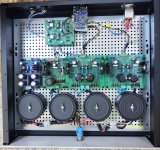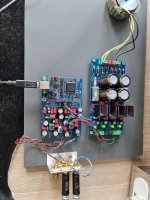DAC board for PCM56 can be used for AD1856 (drop in replacement) and AD1860 and maybe something else. As the AD1860 is an 18bit DAC, pin to pin compatible with PCM56 (16bit), it has a jumper for 18bit and 16bit on the board, so it should be connected to the chip that is used.
In terms of sound, the AD1856 sounds very similar to the PCM56, maybe a little brighter sounding, but minimal. The AD1860 sounds softer and more fluid than the PCM56 which is a bit more raw sounding. This can all be corrected with various OPAs in the I/V part that affect the sound more than the DAC chip itself. If I didn't make these stronger models, I could live with some of them for a while. Each DAC chip has to work for a while to stabilize the sound. Out of the bag, after 30+ years of being in a warehouse, they don't sound their best from the start.
In this configuration, PCM56, AD1856 and AD1860 can work 24 bit but only up to 96kHz sampling rate. For more than that, one has to go for AD1865, AD1862, PCM1702 and PCM63. They run all the way up to 384kHz without any problems.
In terms of sound, the AD1856 sounds very similar to the PCM56, maybe a little brighter sounding, but minimal. The AD1860 sounds softer and more fluid than the PCM56 which is a bit more raw sounding. This can all be corrected with various OPAs in the I/V part that affect the sound more than the DAC chip itself. If I didn't make these stronger models, I could live with some of them for a while. Each DAC chip has to work for a while to stabilize the sound. Out of the bag, after 30+ years of being in a warehouse, they don't sound their best from the start.
In this configuration, PCM56, AD1856 and AD1860 can work 24 bit but only up to 96kHz sampling rate. For more than that, one has to go for AD1865, AD1862, PCM1702 and PCM63. They run all the way up to 384kHz without any problems.
Last edited:
@miro1360 , look at my post here , https://www.diyaudio.com/community/...ate-nos-dac-using-tda1541a.79452/post-7532076
Thorsten Loesch in the post above made us a great gift for Christmass. Maybe you can make some pcbs with his permission in the sharing spirit you iniated since the beginning of this thread. Btw you or others.
best wisches for the christmass holydays.
Thorsten Loesch in the post above made us a great gift for Christmass. Maybe you can make some pcbs with his permission in the sharing spirit you iniated since the beginning of this thread. Btw you or others.
best wisches for the christmass holydays.
I finally got around to getting my second Miro AD1862 DAC up and running. My first build used the shift registers but with this build I bypassed the shift registers and used an older JLSounds USB to I2S board. Next I need to finish my CEN IV and try it out with this build to see how it sounds. So far it sounds great.
Attachments
The wirering layout is very clean 🙂. What are the torroids with their good boxes and the reg pcbs used ?
Everything was reused from older projects. The PSU are Chinese studer clones, not bad. The toroid shields are old tuna cans, looks better than the toroids alone, and might provide some shielding, who knows. The bottom line is that it sounds essentially the same as my first copy. Which is very good. Now I'll see how the IV and filter can affect the sound for my self.
is modushop the only place to get those kinds of baseplates? they're really useful for floorplanning more complex projects like these
I got mine through the DIYAudio store, not sure of someone else offers them. They are very useful and handy to have. I had to drill a few more holes to get the boards to mount correctly, but great for tying the wiring to.is modushop the only place to get those kinds of baseplates? they're really useful for floorplanning more complex projects like these
Another finished ad1862 dac. Even with cheap opa1655 produce wonderful sound. Thank you Miro. Next will be separate psu for jlsound and Burson or Grunf/Vunce ad811 IV. Anyone tried balanced output? Probably could be done with additional dac pcb populated only IV part.
Attachments
You could use a balanced line driver, like THAT1646 or DRV134. But like a transformer, it would be downstream of the ‘normal’ output.
I’ve got a set of transformers I’ll try with mine.
I’ve got a set of transformers I’ll try with mine.
I have some amorphous cores which normally use for ribbon tweeter step-up. Need to find suitable in/out impedance and ratio. I can experiment with that.
use flux on your solderings 😛
What are the brown things marked 22 ?
The DIP 8 maybe problematic with some high speeds oaps as you know. Better for your tests before final solderings to use flat soic to DIL adapter you plug w/o soldering for audio tests before your final choice, imho. I should have some pictures of that in the thread last 1/3 part circa, but sorry doesn't remember where (Miro had not linked my tests, lol). But I advise for a lot for a simple good sound to copy the resistor I/V I choose as the old red cap 0.1 uF with Pan FC cap for the operational (1655/56) ! Works great in a benchmark VS my ref DAC (complex TDA1541A dac that goes a little better everywhere, but far more complex).
YMMV and some would have different inputs. (I hate for good sound RN55 resistors and Silmic II caps)
What are the brown things marked 22 ?
The DIP 8 maybe problematic with some high speeds oaps as you know. Better for your tests before final solderings to use flat soic to DIL adapter you plug w/o soldering for audio tests before your final choice, imho. I should have some pictures of that in the thread last 1/3 part circa, but sorry doesn't remember where (Miro had not linked my tests, lol). But I advise for a lot for a simple good sound to copy the resistor I/V I choose as the old red cap 0.1 uF with Pan FC cap for the operational (1655/56) ! Works great in a benchmark VS my ref DAC (complex TDA1541A dac that goes a little better everywhere, but far more complex).
YMMV and some would have different inputs. (I hate for good sound RN55 resistors and Silmic II caps)
ahaha, I surmise it was not soldered by you ! But you asked* eventually...
* it is more sensible to PS, passive parts choice as op choice, traffos. Dacs are susceptive...
* it is more sensible to PS, passive parts choice as op choice, traffos. Dacs are susceptive...
- Home
- Source & Line
- Digital Line Level
- DAC AD1862: Almost THT, I2S input, NOS, R-2R


